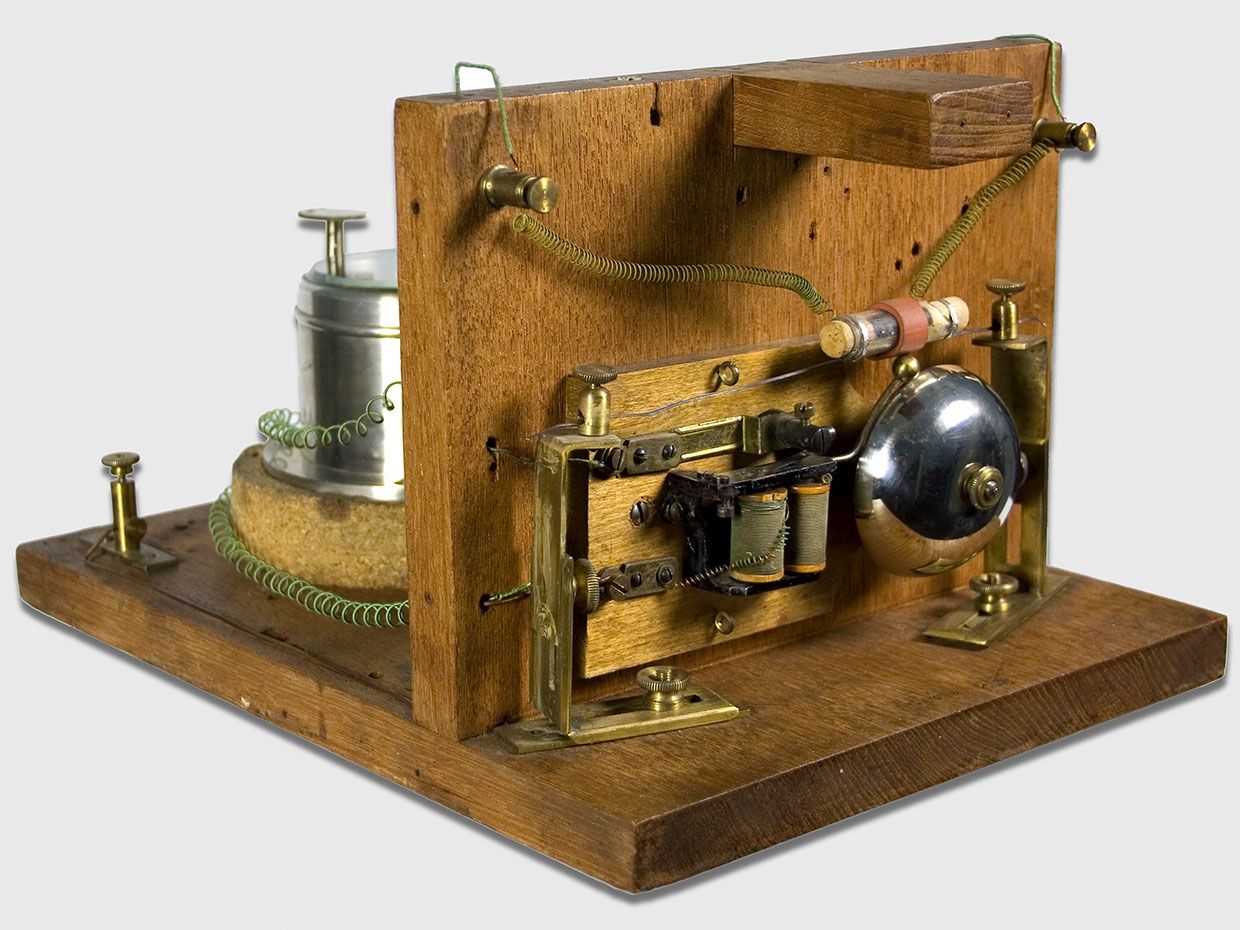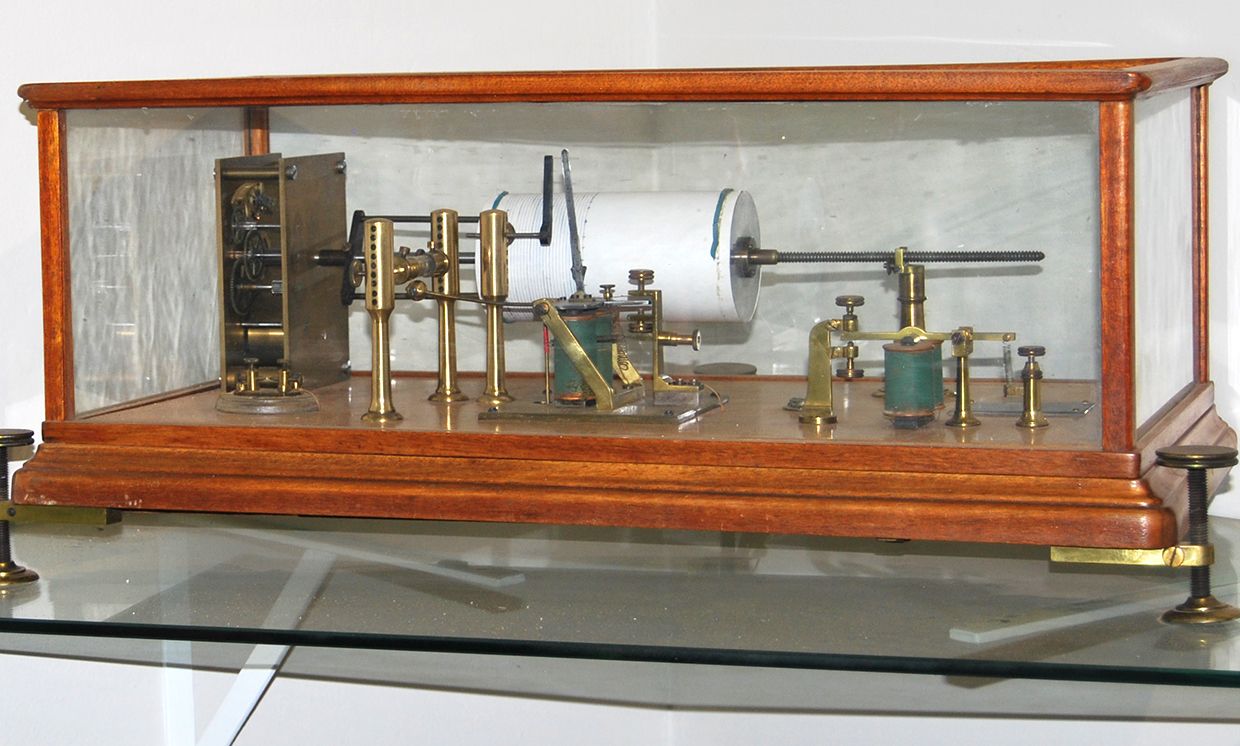Who Invented Radio: Guglielmo Marconi or Aleksandr Popov?
 Photo: A.S. Popov Central Museum of Communications In 1895, Russian physicist Aleksandr Popov used his lightning detector to demonstrate the transmission of radio waves.
Photo: A.S. Popov Central Museum of Communications In 1895, Russian physicist Aleksandr Popov used his lightning detector to demonstrate the transmission of radio waves. Who invented radio? Your answer probably depends on where you're from.
On 7 May 1945, the Bolshoi Theater in Moscow was packed with scientists and officials of the Soviet Communist Party to celebrate the first demonstration of radio 50 years prior, by Aleksandr S. Popov. It was an opportunity to honor a native son and to try to redirect the historical record away from the achievements of Guglielmo Marconi, widely recognized throughout most of the world as the inventor of radio. Going forward, 7 May was declared to be Radio Day, celebrated across the Soviet Union and still celebrated in Russia to this day.
The claim for Popov's primacy as radio's inventor came from his presentation of a paper, On the Relation of Metallic Powders to Electrical Oscillations," and his demonstration of a radio-wave detecting apparatus at St. Petersburg University on 7 May 1895.
Aleksandr Popov Developed the First Radio Capable of Distinguishing Morse Code Photo: Interfoto/Alamy A year after his 1895 demonstration, Aleksandr Popov used his radio apparatus to send a Morse code message.
Photo: Interfoto/Alamy A year after his 1895 demonstration, Aleksandr Popov used his radio apparatus to send a Morse code message. Popov's device was a simple coherer-a glass tube with two electrodes spaced a few centimeters apart with metal filings between them. The device was based on the work of French physicist Edouard Branly, who described such a circuit in 1890, and of English physicist Oliver Lodge, who refined it in 1893. The electrodes would initially have a high resistance, but when they were hit with an electric impulse, a low-resistance path would develop, allowing conductivity until the metal filings clumped together and the resistance became too steep. The coherer had to be tapped or shaken after each use to rescatter the filings.
According to the A. S. Popov Central Museum of Communications, in St. Petersburg, Popov's device was the world's first radio receiver capable of distinguishing signals by duration. He used a Lodge coherer indicator and added a polarized telegraph relay, which served as a direct-current amplifier. The relay allowed Popov to connect the output of the receiver to an electric bell, recorder, or telegraph apparatus, providing electromechanical feedback. [The device at top, from the museum's collections, has a bell.] The feedback automatically reset the coherer: When the bell rang, the coherer was simultaneously shaken.
On 24 March 1896, Popov gave another groundbreaking public demonstration, this time sending Morse code via wireless telegraphy. Once again at St. Petersburg University at a meeting of the Russian Physicochemical Society, Popov sent signals between two buildings 243 meters apart. A professor stood at the blackboard in the second building, recording the letters that the Morse code spelled out: Heinrich Hertz.
Coherer-based designs similar to Popov's became the basis of first-generation radio communication equipment. They remained in use until 1907, when crystal receivers eclipsed them.
Popov and Marconi Had Very Different Views About RadioPopov was a contemporary of Marconi's, but the two men developed their radio apparatuses independently and without knowledge of the other's work. Making a definitive claim of who was first is complicated by inadequate documentation of events, conflicting definitions of what constitutes a radio, and national pride.
One of the reasons why Marconi gets the credit and Popov doesn't is that Marconi was much more savvy about intellectual property. One of the best ways to preserve your place in history is to secure patents and publish your research findings in a timely way. Popov did neither. He never pursued a patent for his lightning detector, and there is no official record of his 24 March 1896 demonstration. He eventually abandoned radio to turn his attention to the newly discovered Rontgen waves, also known as X-rays.
Marconi, on the other hand, filed for a British patent on 2 June 1896, which became the first application for a patent in radiotelegraphy. He quickly raised capital to commercialize his system, built up a vast industrial enterprise, and went on to be known-outside of Russia-as the inventor of radio.
Although Popov never sought to commercialize his radio as a means of sending messages, he did see potential in its use for recording disturbances in the atmosphere-a lightning detector. In July 1895, he installed his first lightning detector at the meteorological observatory of the Institute of Forestry in St. Petersburg. It was able to detect thunderstorms up to 50 kilometers away. He installed a second detector the following year at the All-Russia Industrial and Art Exhibition at Nizhny Novgorod, about 400 km east of Moscow.
Within several years, the clockmaking company Hoser Victor in Budapest was manufacturing lightning detectors based on Popov's work.
A Popov Device Found Its Way to South AfricaOne of those machines made it all the way to South Africa, some 13,000 km away. Today, it can be found in the museum of the South African Institute for Electrical Engineers (SAIEE) in Johannesburg.
Now, it's not always the case that museums know what's in their own collections. The origins of equipment that's long been obsolete can be particularly hard to trace. With spotty record keeping and changes in personnel, institutional memory can lose track of what an object is or why it was important.
That might have been the fate of the South African Popov detector, but for the keen eye of Dirk Vermeulen, an electrical engineer and longtime member of the SAIEE Historical Interest Group. For years, Vermeuelen assumed that the object was an old recording ammeter, used to measure electric current. One day, though, he decided to take a closer look. To his delight, he learned that it was probably the oldest object in the SAIEE collection and the only surviving instrument from the Johannesburg Meteorological Station.
 Photo: South African Institute of Electrical Engineers A Popov lightning detector used at the Johannesburg Meteorological Station now resides in the museum of the South African Institute of Electrical Engineers.
Photo: South African Institute of Electrical Engineers A Popov lightning detector used at the Johannesburg Meteorological Station now resides in the museum of the South African Institute of Electrical Engineers. In 1903 the colonial government had ordered the Popov detector as part of the equipment for the newly established station, located on a hill on the eastern edge of town. The station's detector is similar to Popov's original design, except that the trembler used to shake up the filings also deflected a recording pen. The recording chart was wrapped around an aluminum drum that revolved once per hour. With each revolution of the drum, a separate screw advanced the chart by 2 millimeters, allowing activity to be recorded over the course of days.
Vermeulen wrote up his discovery [PDF] for the December 2000 Proceedings of the IEEE. Sadly, he passed away about a year ago, but his colleague Max Clarke arranged to get IEEE Spectrum a photo of the South African detector. Vermeulen was a tireless advocate for creating a museum to house the SAIEE's collection of artifacts, which finally happened in 2014. It seems fitting that in an article that commemorates an early pioneer of radio, I also pay tribute to Vermeulen and the rare radio-wave detector that he helped bring to light.
An abridged version of this article appears in the May 2020 print issue as The First Radio."
Part of a continuing series looking at photographs of historical artifacts that embrace the boundless potential of technology.
About the AuthorAllison Marsh is an associate professor of history at the University of South Carolina and codirector of the university's Ann Johnson Institute for Science, Technology & Society.